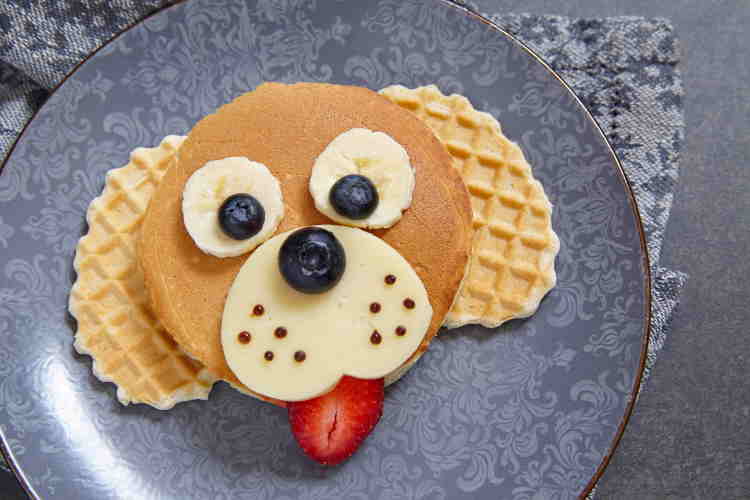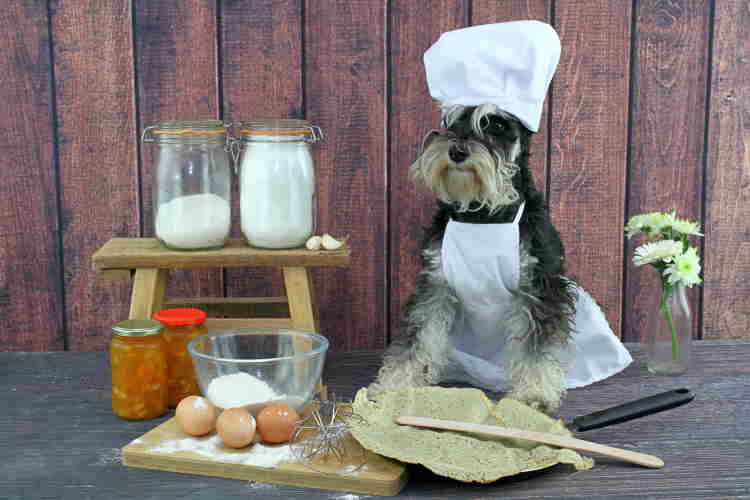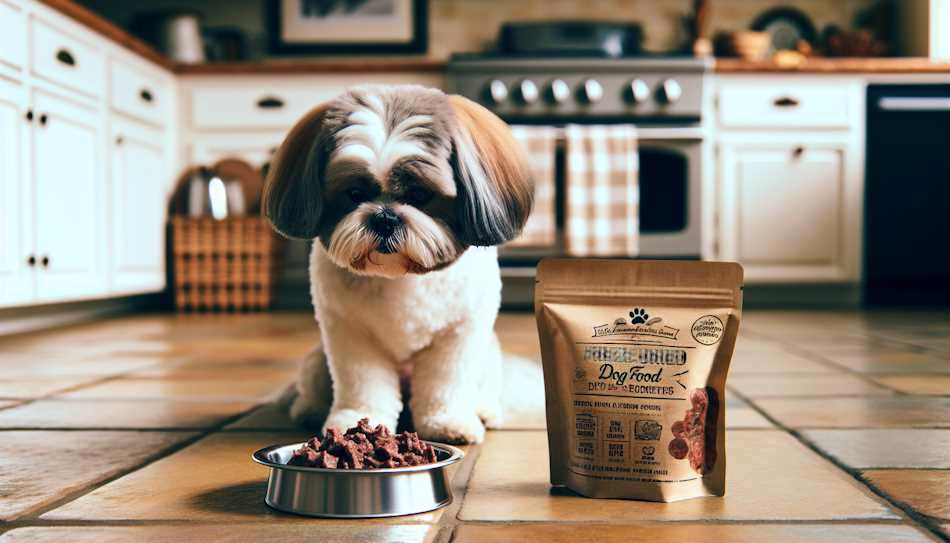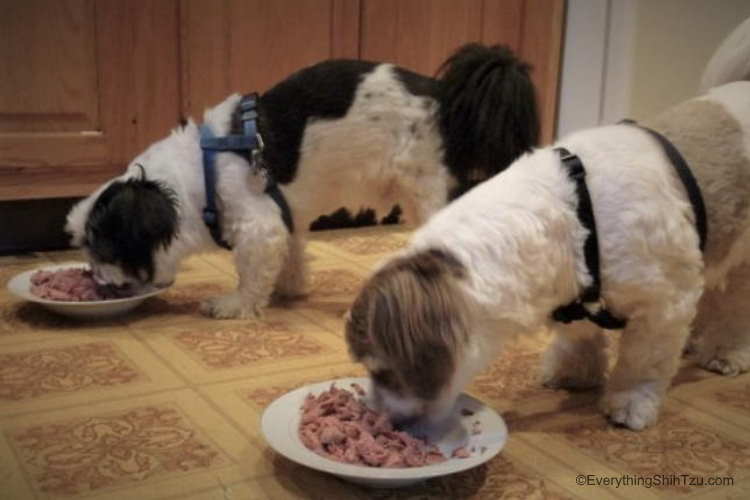- Home
- Shih Tzu diet
- pancakes and dogs
Can Dogs Eat Pancakes?
What ingredients to avoid when giving your dog a pancake treat
BY MOLLY | EVERYTHINGSHIHTZU.COM
This post may contain affiliate links. Read privacy & disclosure policy for info
There’s something about a pancake breakfast that seems to make the day even better.
It could be the warm, fluffy goodness or the way it brings back childhood memories. Plus, you can choose from endless topping options, from syrup to fruit to jams and more.

But, as good as they taste, pancakes aren’t always the healthiest option, so they’re typically more of a once-and-a-while kind of breakfast.
However, what about your Shih Tzu, should they indulge in a pancake feast now and then, too?
Dogs can enjoy some occasional pancakes, but the key word here is occasional. Although plain pancakes are not toxic to pups, they aren’t good for them either. Mainly because of the high carbohydrate and sodium content.
If you opt to feed your dog some pancakes, do so in small amounts as a special treat, and ensure the pancakes are plain.
Pancakes come in all different forms and flavors.
Some pancakes even boast that they’re healthy because they’re made with special ingredients or use sugar-free toppings.
However, these different bits and parts can include some toxic components for your pup (like sugar-free syrup that contains xylitol).
So, stick to a plain, classic pancake and keep these important points in mind.
What’s In a Pancake (and why is it not the best for dogs)?
Typically, a pancake consists of some oil, eggs, flour, milk, sugar, and salt.
While none of these ingredients are poisonous to dogs, it’s essential to look at the big picture.
There are a few other considerations besides the obvious things (like feeding your dog too much table food can lead to undesirable effects, like begging, plus overeating, and obesity).
A basic, 4-inch pancake contains roughly 1 gram of fat, 8 carbs, 1 gram of protein, 45 calories, and a whopping 106 milligrams of sodium.
To put this in perspective, a 30-pound dog should consume no more than 100 milligrams of sodium per day (although this can fluctuate a bit depending on a dog’s activity level, age, etc.).
Therefore, consider your Shih Tzu, who likely weighs between 12 and 16 pounds, and you can see why feeding her too much pancake could pose a problem.
However, most of the time, especially if you buy your pancakes at the local diner, these numbers can jump.
For example, a buttermilk pancake the same size contains about 3.5 grams of fat, 11 carbs, 2.5 grams of protein, 86 calories, and an astounding 200 milligrams of sodium.
What Can Too Much Sodium Do to a Dog?
Sodium is an essential part of your pup’s diet; it helps regulate her nerve function, blood pressure and maintains muscle cell function and other benefits.
However, you can always have too much of a good thing.
Basically, just like too much sodium is not ideal for humans, it’s definitely not a good idea for your dog.
If your dog consumes too much sodium, it can lead to a host of health issues. These issues can include high blood pressure, kidney failure, and cardiac disease.
Excess sodium in the blood is known as hypernatremia, and it causes an electrolyte imbalance that can become life-threatening if it reaches a certain point.
If you think your dog has had too much sodium, you might notice increased urination and thirst.
Other potential signs of excess sodium are:
- Vomiting
- Diarrhea
- Appetite loss
- Lethargy or weakness
- Swelling
- Confusion or incoordination
- Decreased energy
- Increased heart rate
- Seizures
In extreme cases, too much sodium can result in poisoning that leads to coma or death.
However, the most common signs are excessive drinking and urinating.
Your pup could be drinking a lot to try and rid her body of excess sodium and restore balance.
If you suspect your dog might have high levels of sodium in her blood, your vet can tell for sure with a blood or urine test.
Therefore, get your dog to the vet as soon as possible for a thorough examination and testing.
If your vet determines your dog has too much sodium in her blood, she’ll likely begin treatment that includes IV therapy to restore balance and prevent dehydration.
This process could take anywhere from one to three days, so expect your pup to be admitted to the doggy hospital.
Pancakes Please, In Moderation (Hold the Syrup)
So, if you’re going to feed your pup a few pieces of pancake, that’s fine.
Just be aware of exactly what is in the pancakes, and feed your dog in moderation. Also, it’s best to serve them plain.
Forget the syrup, jams, and yes, even the “healthy” fruits.
While certain fruits, like bananas and blueberries, are safe for dogs to eat and even contain some health benefits, they also add unnecessary sugar to pancakes.
Syrup is especially high in sugar which can lead to issues for your pup, including obesity.
You might think the sugar-free syrup is a good solution, but sugar-free products can actually be toxic as many contain xylitol, which is poisonous for dogs.
If you pick up pancakes at a restaurant or diner, it’s crucial to steer clear of ones that might add things into the batter, like chocolate chips and different types of nuts, which can pose hazards for your dog.
What About Waffles? Can dogs eat waffles?
When it comes to waffles, many of the same rules apply.
Your dog can eat a few pieces of waffle safely, but don’t make a habit of it.
Waffles are especially high in fat and sugar, which aren’t good for your pup. Likewise, as with pancakes, keep the waffles plain.
Dog-Friendly Buckwheat Pancakes

If you really want to indulge your canine companion with a pancake party, your best bet is to make them yourself.
In fact, why not take it one step further and make some dog-friendly pancakes?
These buckwheat options are gluten-free, making them a good choice for pups with sensitive stomachs, and they don’t call for adding salt.
(adapted from Rover.com)
- 200 grams of buckwheat flour
- 17 ounces of milk
- 2 medium-sized eggs
- 1 tsp of vegetable oil
Place the flour in a mixing bowl, and using a spatula or spoon, create a well by pushing the flour to the sides of the bowl. In another bowl, whisk together the eggs and milk, and pour the mixture into the well.
Whisk everything together until it is nice and smooth, then place in the fridge for about 15 minutes.
After 15 minutes have passed, heat the vegetable oil in a frying pan and pour some batter into the pan.
Cook for about 30 seconds, then flip and continue to cook for about a minute.
Let cool, cut up into small pieces, and serve to your eager pup.
Note: Always check with your Veterinarian before giving your dog pancakes or any homemade foods, especially if they are on a special diet.
- Home
- Shih Tzu diet
- pancakes and dogs



